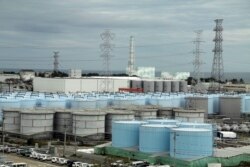Japan has changed its plan for cleaning up the Fukushima nuclear plant. The change further delays the removal of used nuclear fuel that has remained in cooling pools since the 2011 disaster.
The removal process is difficult because of high radiation levels and other risks. But the government and the plant’s owner, Tokyo Electric Power or TEPCO, are aiming to complete the task within 30 to 40 years.
More than 4,700 units of fuel rods
After the earthquake and tsunami, more than 4,700 fuel rod units remain at the three melted reactors and two surviving reactors. The fuel rods present a high risk because their storage pools are uncovered. If another major disaster were to cause a loss of water, the fuel rods could melt, releasing radiation.
Their removal was first planned in 2018. But it has now been postponed for up to 10 years in order to reduce radiation and to clear other waste.
Million tons of radioactive water
TEPCO has been unable to release 1.2 million tons of water kept in nearly 1,000 tanks at the Fukushima center. It is feared that the release of radioactive water will harm fishing and agriculture in the area.
The plant can only store up to 1.37 million tons of water. And the amount of water is growing by 170 tons every day because it is used to cool the melted fuel inside the reactors. At this rate, TEPCO says the plant will run out of storage space by the summer of 2022.
Japan’s government recently wrote a proposal to release the water after treatment. The water is still somewhat radioactive, but TEPCO says further treatment can remove all but radioactive tritium to levels acceptable for release. Experts say tritium is not harmful to humans in small amounts and has been regularly released from nuclear plants around the world.
No plan for disposal of melted fuel, radioactive waste
The biggest difficulty for Japan is the removal of an estimated 880 tons of melted fuel from Fukushima’s three severely damaged reactors. The amount is six times larger than what was found after the 1979 Three Mile Island partial meltdown in the United States.
A robotic arm was developed for the task. The removal will begin with just a spoonful at first. The fuel will then be carefully measured and studied under International Atomic Energy Agency instructions.
Japan hopes to slowly expand the process of removal with new methods and robotic development. However, the country has yet to develop a plan to dispose of the highly radioactive melted fuel and other waste from the reactors.
TEPCO and the government say they plan to build a storage area for radioactive waste from Fukushima. But finding a place and getting public support will be difficult.
Cost of clean-up
The Japanese government estimates that the cost of the clean-up for Fukushima is about $73 billion. That number could grow to $200 billion with storage facilities and added compensation and clean-up of the areas surrounding the nuclear center.
The Japan Center for Economic Research, however, suggests that the cost of clean-up for the nuclear plant alone could be as high as $470 billion.
I’m John Russell.
Mari Yamaguchi reported this story for the Associated Press. John Russell adapted it for Learning English. Hai Do was the editor.
______________________________________________________________
Words in This Story
rod – n. a straight, thin stick or bar
unit – n. a single thing, person, or group that is a part of something larger
spoonful – n. as much as a spoon can hold — often + of
dispose of – phrasal verb to throw (something) away : to get rid of (something)
compensation – n. something that is done or given to make up for damage, trouble, etc.
We want to hear from you. Write to us in the Comments Section.









